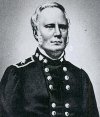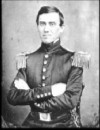Tour Stop
Directions: Walk over to the“Vulnerable in Victory” Interpretive Sign [ Waypoint = N36 27.224 W94 00.930 ] that is located just outside the northeast corner of the rail fence surrounding Elkhorn Tavern.
“Vulnerable in Victory” Interpretive Sign [ Waypoint = N36 27.224 W94 00.930 ] text reads as follows:
 “It was a fiery end to the best day of Earl Van Dorn's 20 years as a professional soldier. Bone-tired from the jarring of a week-long ambulance ride and still feverish with pneumonia, the Confederate commander lay down here in the side yard of Elkhorn Tavern amid the wreckage of the day's battle.”
“It was a fiery end to the best day of Earl Van Dorn's 20 years as a professional soldier. Bone-tired from the jarring of a week-long ambulance ride and still feverish with pneumonia, the Confederate commander lay down here in the side yard of Elkhorn Tavern amid the wreckage of the day's battle.”
“Because he now controlled his enemy's sole supply line, General Van Dorn assumed he had the battle of Elkhorn Tavern won. No one yet knew that the rebel wagons bearing food and ammunition for the next day's fight were hopelessly out of reach.”
“At midnight two young Texans brought word to Confederate headquarters that Generals McCulloch and McIntosh had been killed early in the Leetown fighting. They took orders back for their entire division to march through the night to rejoin Van Dorn here before sunup.”
Description: It's the evening of March 7th and the Confederates have driven the Federals from the area around Elkhorn Tavern. The area in which you are standing was in control of the Federals at the beginning of March 7th. Now the Confederates has forced the Federals to withdraw south towards Pratt's Store after intense fighting throughout the afternoon.
The Confederate troops around Elkhorn Tavern believed they had won the battle on March 7th. Colonel Rosser, commanding the Second Missouri Brigade, described the Southern mood in his official report:
“With this charge closed the day, and at night my men, having been refreshed by provisions which had been captured from the enemy, slept soundly, without tents, blankets, or fire within sight of the Federal camp, which was immediately over the hill beyond us. Our charges having been successful in every instance, officers and men were sanguine that victory was ours, and that the following day would make successful our arms.”
 Major General Sterling Price also felt sanguine about the next day:
Major General Sterling Price also felt sanguine about the next day:
“Night alone prevented us from achieving a complete victory, of which we had already gathered some of the fruits, having taken two pieces of artillery and a quantity of stores.
“My troops bivouacked upon the ground which they had so nobly won almost exhausted and without food, but fearlessly and anxiously awaiting the renewal of the battle in the morning.”
 Colonel Henry Little knew that his men were tired and hungry after the fighting on March 7th:
Colonel Henry Little knew that his men were tired and hungry after the fighting on March 7th:
“Our men, exhausted by the exertions of the day, after a fast of thirty-six hours, were now relieved by the descent of night, and under favor of the obscurity rested upon their arms on the field whence they had driven an obstinate and stubborn foe.”
Colonel John T. Hughes' cavalry regiment also spent a long night:
“The right wing, including my command, now fell back to the summit of the mountain and laid on their arms all night without refreshments. Never did men bear up with more true courage and fortitude under the trying circumstances in which they were placed, without any comforts, without fire, food, or blankets. Weary, hungry, and fatigued with the march for several days previous, and with one days hard fighting, my men stood ready early in the morning, without breakfasting, to renew the struggles of yesterday.”
On the Confederate right to the west of Elkhorn Tavern, Colonel Rosser was in command of the Second Missouri Brigade. To Rosser's left was Colonel Little, commanding the First Missouri Brigade who were deployed south of Elkhorn Tavern across the Wire Road. Supporting Little were the 4th Texas Cavalry and the 1st Arkansas Mounted Rifles. To Little's left were the 16th and 17th Arkansas Regiments, who had been able to move over from the fighting at Leetown. Deployed along the northern edge of Ruddick's Field were the Missouri State Guard. Guarding the Confederate left flank were the 1st Missouri Cavalry commanded by Colonel Elijah Gates and Cearnal's Missouri Cavalry Battalion commanded by Major D. Todd Samuels because Lt. Colonel Cearnal had been wounded. Van Dorn also deployed the 2nd Cherokee Mounted Rifles to protect his right flank.
 “It was a fiery end to the best day of Earl Van Dorn's 20 years as a professional soldier. Bone-tired from the jarring of a week-long ambulance ride and still feverish with pneumonia, the Confederate commander lay down here in the side yard of Elkhorn Tavern amid the wreckage of the day's battle.”
“It was a fiery end to the best day of Earl Van Dorn's 20 years as a professional soldier. Bone-tired from the jarring of a week-long ambulance ride and still feverish with pneumonia, the Confederate commander lay down here in the side yard of Elkhorn Tavern amid the wreckage of the day's battle.” Major General
Major General  Colonel Henry Little knew that his men were tired and hungry after the fighting on March 7th:
Colonel Henry Little knew that his men were tired and hungry after the fighting on March 7th: